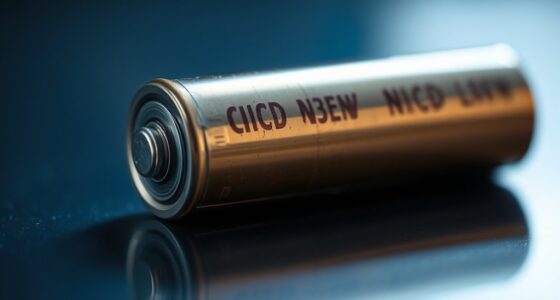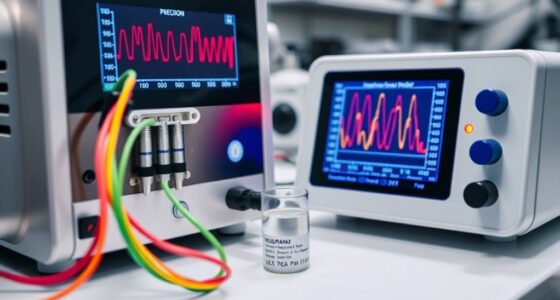Bio-batteries harness biological materials like enzymes and organic molecules to produce electricity from natural processes. They convert waste substances into clean energy, offering a sustainable alternative to traditional batteries. The key to their success lies in improving enzyme efficiency and developing durable materials that resist environmental conditions. When both factors work together, bio-batteries can deliver longer-lasting, high-performance power sources. Keep exploring to discover how advances in this exciting technology are shaping the future of energy storage.
Key Takeaways
- Bio-batteries utilize enzymes and biological molecules to convert organic substances into electrical energy sustainably.
- Enzyme efficiency directly impacts the energy output and overall performance of bio-batteries.
- Material durability ensures bio-battery stability by resisting environmental stresses like pH, temperature, and chemical exposure.
- Advances in enzyme engineering and durable materials enhance bio-battery lifespan and power generation capabilities.
- Balancing enzyme activity with material stability is essential for practical, long-lasting biological energy storage solutions.

Bio-batteries are innovative energy sources that harness biological materials to generate electricity. They work by using enzymes and other biological molecules to catalyze chemical reactions, converting organic substances into electrical energy. This approach offers a sustainable alternative to traditional batteries, tapping into nature’s own processes to produce power. As you explore bio-batteries, you’ll find that their success hinges on two key factors: enzyme efficiency and material durability. These elements determine how effectively the biological catalysts work and how long the battery can operate under real-world conditions.
Enzyme efficiency is essential because enzymes serve as the biological catalysts that speed up the reactions needed to generate electricity. If enzymes aren’t efficient enough, the energy output drops, and the battery’s performance suffers. Researchers are continually working to improve enzyme efficiency through genetic engineering and optimized enzyme immobilization techniques. Enhancing enzyme activity means the bio-battery can produce more power at a faster rate, making it more viable for practical applications. You’ll notice that advances in enzyme stability directly impact the longevity of the device, as unstable enzymes tend to degrade quickly, reducing overall lifespan. Achieving high enzyme efficiency ensures that the bio-battery can sustain consistent energy production over an extended period.
Enhancing enzyme efficiency boosts bio-battery power and longevity for practical, sustainable energy solutions.
Material durability also plays a fundamental role. The materials used to contain and support biological components must withstand the harsh conditions inside the battery, such as fluctuations in pH, temperature, and exposure to reactive chemicals. If the materials aren’t durable enough, they’ll degrade or break down, leading to leaks, short circuits, or complete failure. To prevent this, scientists are developing robust, biocompatible materials that can endure prolonged use without losing functionality. These durable materials help maintain the structural integrity of the bio-battery, ensuring reliable operation over time. You’ll appreciate that durable materials also protect sensitive biological components from environmental damage, which is essential for maintaining enzyme activity and overall system stability.
When designing bio-batteries, balancing enzyme efficiency with material durability is essential. Improving one without considering the other can lead to suboptimal results. For instance, a highly efficient enzyme is useless if the supporting materials disintegrate quickly, and durable materials won’t be effective if they inhibit enzyme activity. By focusing on both aspects, researchers aim to develop bio-batteries that are not only powerful but also long-lasting. As you look into future applications, it’s clear that progress in enzyme efficiency and material durability will determine how widely bio-batteries can be adopted—from powering small devices to large-scale energy storage systems. Ultimately, these innovations could revolutionize how we think about clean, sustainable energy sources. Moreover, advancements in material science are crucial for overcoming current limitations and enhancing overall device performance.
Frequently Asked Questions
How Long Do Bio-Batteries Typically Last Before Replacement?
Bio-batteries usually last between a few days to several weeks before needing replacement, depending on their design and usage. The lifespan duration varies because of factors like the type of biological materials used and how often you cycle the battery. Generally, the replacement frequency is relatively high compared to traditional batteries, so you’ll need to monitor their performance closely and plan for regular replacements to guarantee consistent energy supply.
Are Bio-Batteries Environmentally Safer Than Traditional Batteries?
Bio-batteries are generally safer for the environment than traditional ones, acting like gentle giants rather than ticking time bombs. Their biodegradability benefits mean they break down naturally, reducing pollution. Plus, they use renewable resources, lowering the impact on our planet. You can feel good knowing that choosing bio-batteries helps protect ecosystems and decreases hazardous waste, making them a cleaner, greener energy solution for your tech needs.
What Are the Main Challenges in Commercializing Bio-Batteries?
You’ll face challenges like scalability issues, making it hard to produce bio-batteries efficiently at large scales. Regulatory hurdles also slow down commercialization, as these batteries often require extensive testing and approval processes. Overcoming these obstacles means investing in research to improve manufacturing methods and working with regulators to establish clear standards. If you can address scalability and regulation, bio-batteries could become a viable, eco-friendly energy solution.
Can Bio-Batteries Be Used in High-Power Applications?
You can use bio-batteries in high-power applications, but scalability challenges and material durability limit their effectiveness. These batteries often struggle to deliver quick, high bursts of energy because biological components may degrade over time, affecting performance. To succeed in high-power uses, you’ll need to address these issues by improving material stability and finding ways to scale up manufacturing without compromising efficiency.
How Do Bio-Batteries Compare Cost-Wise to Conventional Energy Storage?
Cost comparisons can be challenging, but bio-batteries often cost more initially due to complex manufacturing expenses. However, they offer compelling cost efficiency over time, especially in sustainable and eco-friendly energy storage. You might find that their biodegradable nature reduces disposal costs, balancing higher upfront investments. While conventional batteries typically boast lower starting prices, bio-batteries promise long-term savings through renewable, biologically-based benefits, making them a competitive, eco-conscious alternative.
Conclusion
Just as Prometheus brought fire to humanity, bio-batteries hold the promise of revealing nature’s hidden energy. By harnessing biology’s ingenuity, you can tap into sustainable power sources that operate quietly and efficiently. As scientists continue to innovate, you’re on the brink of a future where energy storage becomes as natural as the flow of life itself. Embrace this new era, and let bio-batteries be your modern torch, illuminating a greener tomorrow.










